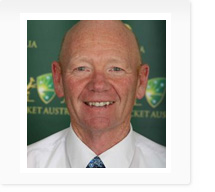Paul Montgomery and I conducted a trial at the City of Casey Ovals on the 13th September 2000. The idea being that we get as close to a realistic game scenario as possible. A second trial was conducted at Cheltenham Secondary College on the 19th September. The pitch had already been trialed at Camberwell Magpies and Ringwood Cricket Clubs with varying degrees of success and not in ideal conditions.
In the trial at Casey we laid the pitch over a compacted dirt car park areas. Although the substrate for the pitch was slightly undulating it was as close as we could get to the appropriate style base for the product as suggested by the manufacturer (Flicx). The other trial at Cheltenham Secondary College was over a standard concrete pitch located in training nets.
NB- The manufacturers suggest that the product be laid over a firm even base. The more consolidated the substrate is the better the performance of the product.
We used various 156g balls for the trial, from reasonably new to quite worn. My findings are as follows…
- The bounce and carry for both medium pace bowling and spin bowling was more than adequate and similar to that of synthetic grass over concrete.
- The ball seemed both ways in a moderate fashion with no alarming variance.
- Both off spin and leg spin were trialed and the pitch responded favorably when spin was affected correctly.
- Batsmen commented that they were happy with the way the ball came through and had no problem keeping their footing with standard style rubber soled cricket shoes. Bowler’s comments were of a similar nature. (The players involved were all used to Synthetic grass or matting pitches)
- The pitch lays flat with only a small rise along the edge, (approximately 12mm); with this problem eradicated if the pitch is embedded slightly into the surface (Grass removed or rolled firmly)
- There is no doubt that this pitch will not perform up to standard if laid on top of long grass or over an under-prepared substrate.
- The product is guaranteed against UV for a period of 15 years under constant exposure to the elements and, unless stolen, is almost a lifetime product. One area that is exposed to wear and tear on a continual basis is where the bat is continually tapped down whilst the bowler is coming in. This is well catered for in the fact that the product is made up of interlocking squares of approximately 100mm each and pieces can be removed and added where applicable.
- The pitch can come in various colours, bat the basic is green, and the markings (batter’s centre mark, crease line), are already factored into the product when it is made up.
- It rolls up into 2 pieces in a similar manner to standard matting but because of its rigid nature does need a pole or similar through the middle to make it easy to carry. Although it has a fair amount of weight, 2 people can carry it easily. It then fits into the back of a Utility, Van or Station wagon fairly comfortably.
The trials were attended by a number of people from local councils, clubs and associations and the response was very positive indeed. The applications for this type of product are almost limitless given that it is a pick up, roll out and store away style product.
The product will be put into a full time situation probably in October 2000 so further results and viewing of the product can be made available.
Neale Price was a Regional Cricket Manager and Game Development Manager at Cricket Victoria before taking up an appointment in Game Development with Cricket Australia.
Factual points of interest –The Flicx pitch comes in 2 rolls, each roll weighs approximately 67.5kg. A Carry Cradle can be purchased with a Flicx Pitch for ease of transport and to reduce lifting requirements.
